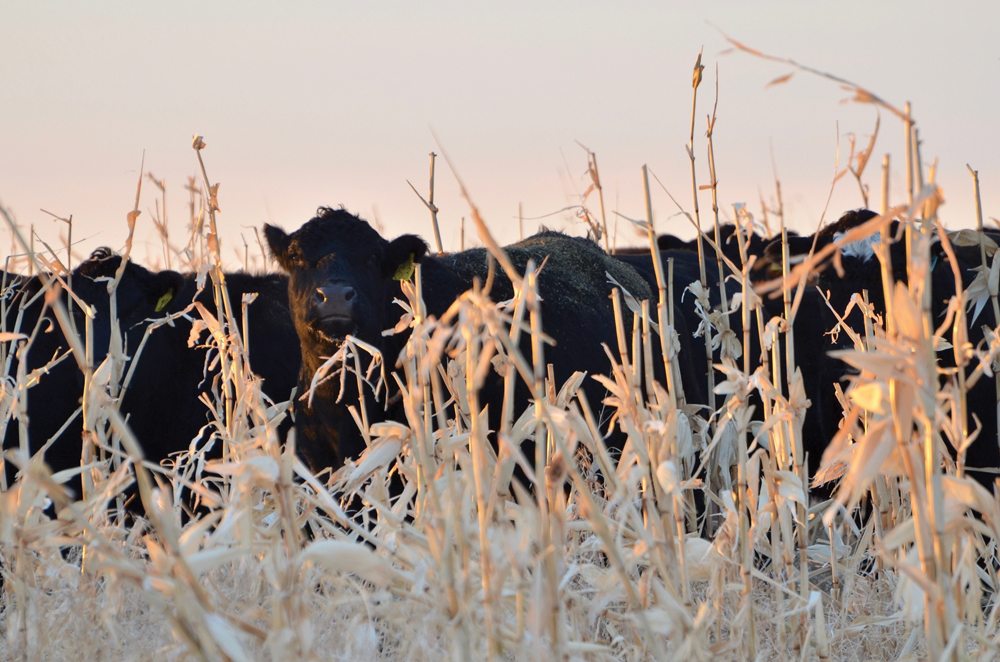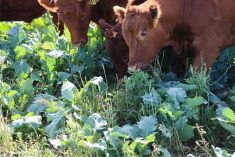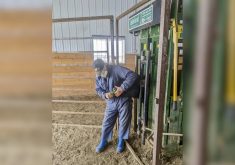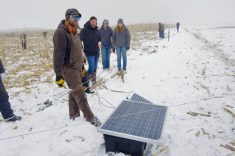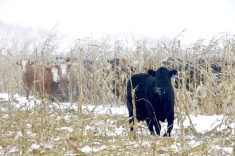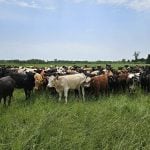Manitobans may feel like they’ve been living in a deep freeze, but some of the province’s cattle have weathered the cold among the cornstalks.
That’s no small feat, as the last days of 2017 dropped to -35 C with wind chills approaching -50 C.
Manitoba Beef and Forage Initiatives (MBFI) near Brookdale winters its animals exclusively in the field through extended grazing. Corn grazing is included in that lineup. Project managers at the research farm say some adjustment had to be made for the bitter cold, including making sure there was enough supplemental feed for the animals.
Read Also
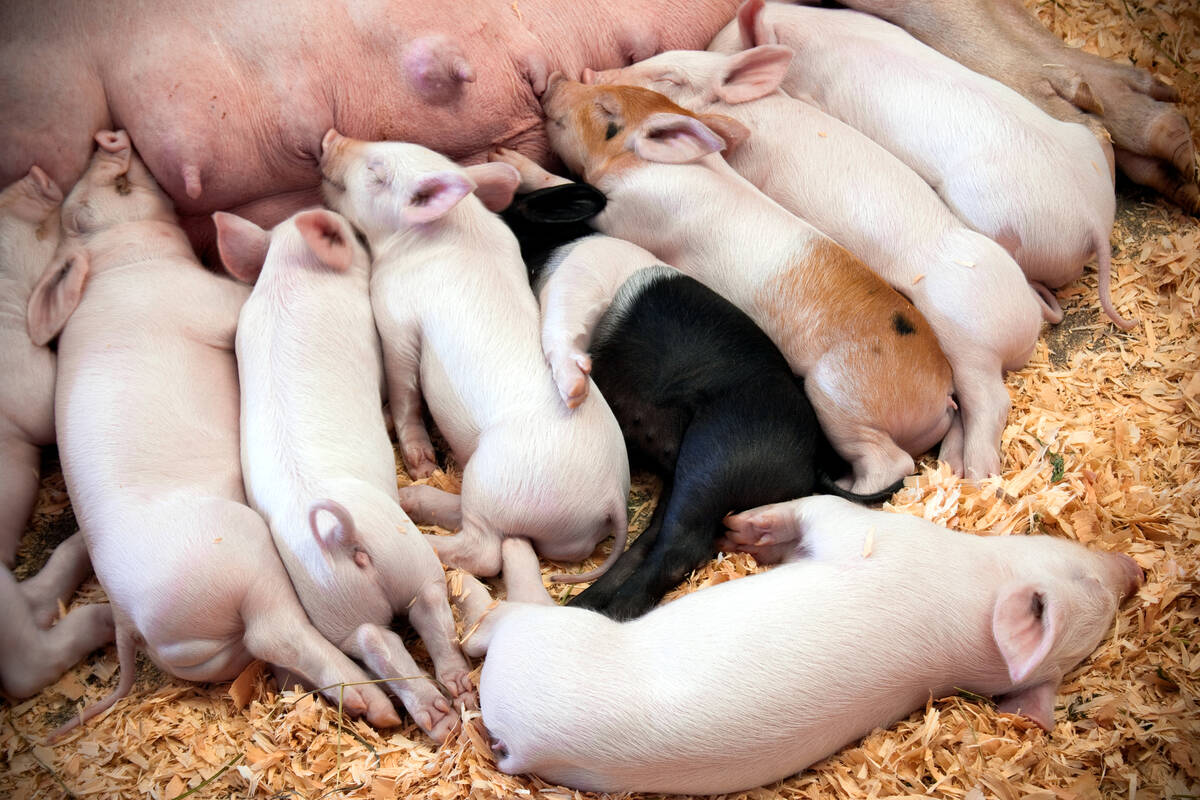
First-time pig mothers may need more lysine
Lysine feed recommendations may fall short for gilt pregnancies when it comes to making sure the mother pig can produce as much milk for her piglets as possible
Shawn Cabak, the lead on MBFI’s winter feeding project, estimates that corn-grazing cattle will need 15 per cent more feed for every 10° drop in temperature.
“When they’re free choice, they will eat more on their own,” he said. “Plus corn is a good source of energy under extreme temperatures and so it works well when you have below-normal temperatures because they’re actually getting more energy than their requirements already.”
MBFI upped feed per animal during the cold spell. The herd was already being supplemented with hay, something Cabak says helped ease transition to corn as well as encourage the herd to clean up more stalks. As temperatures dropped however, hay also filled another role — protein.
One weakness
Corn grazing has attracted producers for its high yields, biomass and energy potential in the sweet cobs. Protein, however, has been a relative weakness of the system.
Bart Lardner, the lead researcher on ongoing corn-grazing projects through the Western Beef Development Centre, tested five corn varieties in 2011-12 and found an average 7.4 per cent protein. Research out of the University of Saskatchewan backed up his findings. In 2015, a trial comparing corn with swath-grazed barley and barley greenfeed found corn had the lowest protein at 8.2 per cent, compared to 10.9-11.2 per cent in the other two feeds.
Corn’s protein is enough for the average cow, Lardner said during a corn-grazing webinar in November, although likely not enough for pregnant cows.
Extreme cold, like what Manitoba has experienced, also ups an animal’s protein requirement.
“It’s important for rations to be balanced for protein, energy, mineral and vitamins,” Cabak said.
The researcher advised a 2-1 mineral with extra calcium or 3-1 mineral to make up for corn’s lower calcium content.
MBFI cattle have been on corn since early December, according to Cabak.
Animals are limited to three to four days’ worth of corn at a time before shifting to the next area of the field.
The timing is designed to provide enough food, while also giving cattle enough time to exhaust the cobs and start eating the leaves, tassels and stalks that will add fibre, producers heard during a mid-December tour at MBFI.
Corn gorging is one of the common risks associated with grazing the crop, and is one of the main reasons that experts advise farmers to transition cattle onto corn slowly and supplement with hay before moving the herd onto the field or into a fresh paddock of corn.
The idea, Cabak said, is to fill up the animals before they reach their new grazing grounds.
On the farm
Ryan Boyd is no stranger to extended grazing. The Forrest-area producer has long experimented with systems like swath grazing and corn grazing.
His herd came through the cold snap, “decently well,” he said, although he found himself fighting with a freezing solar waterer as the mercury dropped. Shelter from the wind has been critical for his animals, he said.
Boyd increased feed to help deal with the cold, although the larger ration created its own problem.
“I baled up some pea greenfeed that has more mature peas in it than I had expected and that has been giving me some grief,” he said. “As I upped the amount of feed in the cold, some acidosis started showing up in the cows from too much grain, a combination effect of corn and peas combined.”
An influx of too much grain may affect rumen pH and cause the metabolic illness, which often appears as animals losing condition, increased temperature, reduced feed intake or dehydration, making water access even more important.
Where’s the water?
Water is vital to extended grazing, Cabak said, and something increasingly likely to be a thorn in the side of producers as temperatures dip.
“Water is critical to ensure that feed consumption is adequate and, with the lack of snow this winter, it may not be adequate,” he said. “We want to ensure that there’s a secondary water source and, with colder temperatures, we actually prefer water over snow just because extra energy is required to melt the snow.”
Brandon, south of the farm, had just over 33 centimetres of snow as of Jan. 11, according to community monitoring network CoCoRaHS.
Snow must also be soft enough for cattle to access for water, Cabak added.
MBFI avoided waterer issues through the cold spat. As part of the project, MBFI is testing a motion-activated gravity waterer that brings water up only when an animal approaches and then drains it back underground, where it is unlikely to freeze.
A Thermo Sink system, which pumps water into partially buried insulated reservoirs, is also installed on site, but has yet to be used in the bitter cold, Cabak said.
The system will be put to the test in the near future as cold returned to Manitoba in the second week of January and MBFI plans to move cattle into that pasture.






